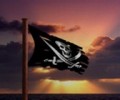Merchant vessels and yachts have begun sailing dangerously close to a still volatile Somali coastline posing a threat to the crew and ships.
A warning to stay clear from the Somali coast that remains a high-risk piracy zone was issued by officers from the European Union Naval Force visiting the UAE ahead of an international counter-piracy conference.
Vessels are moving closer to the Somali coastline because of reduced incidents of pirate attacks and to save money and fuel, said officers aboard the Italian navy destroyer Andrea Doria, the Eunavfor’s flagship to combat piracy.
“It’s not good to see that the shipping companies are already moving so fast and so close to the coast of Somalia,” said Alessandro Mariani, a diplomat from the European External Action Service of the EU.
“Why are they doing that? Because in their mind they judge that the risk has diminished and they can therefore afford to go to routes closer to Somalia. This makes them save financial resources, but in our opinion they are moving too fast towards the coast.”
In 2009 there were 51 hijackings off the Somali coast, in 2012 the figure was seven and dropped to zero in 2013.
Patrolling by naval forces, self-protection measures, armed guards on merchant vessels and sharing intelligence information have dented Somali pirate attacks.
Officials representing 60 countries and 20 international organisations are in Dubai for the Contact Group on Piracy off the Coast of Somalia as part of the UAE Counter-piracy Week.
The Andrea Doria’s UAE visit is linked to the Contact Group meeting that ends on Tuesday. The warship along with other anti-piracy task force ships has provided fuel and supplies to vessels that over the past few months have moved near the Somali coast.
Ulrich Brosowsky, the EU Force headquarter’s chief of staff, said the message to merchant shipping was clear: “This area is still a pirate area, this is still a high-risk area. You have to take precautionary measures and you have to stay away from the Somali coast.”
Two weeks ago a cargo ship carrying 8,000 tonnes of cement travelled along the Somali coast at a speed of five knots and was forced to anchor off the coast when it encountered engine trouble.
The ship was approached by locals offering assistance who began climbing on board. The crew managed to fend them off, restarted the vessel and radioed for help.
The Eunavfor and the Nato task force provided the cargo ship air cover to help them navigate out of the danger zone by identifying where Somali skiffs were located.
“Two years have gone by since the last successful attack and the merchant community has started to close in again on the Somali coast,” Capt Brosowsky said.
The Eunavfor decided last year that its Somalia mission would extend beyond December this year until end-2016 to continue to deter piracy and armed robbery.
“We are not yet in a position of saying, ‘Mission accomplished’,” said Mr Mariani.
“There is a lot of work that has to continue at sea but also at land because the root causes of piracy are on land.”
Rear admiral Guido Rando also called for continued caution.
“The end of mission will be when the Somali people and government take direct control of their safety and security,” he said.
“The situation has improved but we must not be complacent because pirates have not disappeared. There have been many successes but we know the organisation of piracy in Somalia is still intact.”
Source: The National
Copyright Ships & Ports Ltd. Permission to use quotations from this article is granted subject to appropriate credit given to www.shipsandports.com.ng as the source.

